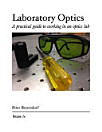Lasers and Holography
জানু ২০১৩ · Courier Corporation
৫.০star
৩টি রিভিউreport
ই-বুক
160
পৃষ্ঠা
reportরেটিং ও রিভিউ যাচাই করা হয়নি আরও জানুন
এই ই-বুকের বিষয়ে
As the words holo (complete) and gram (message) connote, the hologram captures the entire message of a scene in all its visual properties, including the realism of three dimensions. It involves the simple process of photographically recording the pattern formed by two interfering sets of light waves, one of these sets being a reference wave. With the introduction of lasers to holography in 1963, real advances in the development of holography began to take place.
Dr. Kock's lucid introduction to lasers and holography has now been revised and updated for a second edition. It begins with a clear discussion of wave patterns and coherence. Then the development of lasers is summarized, along with the phenomenon of wave diffraction. Finally, the important subjects of zone plates and the properties of holograms are skillfully described. A new, concluding chapter brings the story up to the present, with a survey of recent advances in such areas as viewing holograms, hologram computer memories, liquid surface holography, synthetic-aperture radar and sonar, large new lasers, fiber optics, etc.
Using language that can be readily understood by high school and junior high school students, Dr. Kock has written a brief, yet authoritative volume that should satisfy anyone's curiosity about this burgeoning field. The remarkable discoveries that have already occurred are only a prelude to an even more remarkable future. 84 illustrations, including 8 new to this edition. New preface. Suggested (1981) additional reading. Index.
Dr. Kock's lucid introduction to lasers and holography has now been revised and updated for a second edition. It begins with a clear discussion of wave patterns and coherence. Then the development of lasers is summarized, along with the phenomenon of wave diffraction. Finally, the important subjects of zone plates and the properties of holograms are skillfully described. A new, concluding chapter brings the story up to the present, with a survey of recent advances in such areas as viewing holograms, hologram computer memories, liquid surface holography, synthetic-aperture radar and sonar, large new lasers, fiber optics, etc.
Using language that can be readily understood by high school and junior high school students, Dr. Kock has written a brief, yet authoritative volume that should satisfy anyone's curiosity about this burgeoning field. The remarkable discoveries that have already occurred are only a prelude to an even more remarkable future. 84 illustrations, including 8 new to this edition. New preface. Suggested (1981) additional reading. Index.
রেটিং ও পর্যালোচনাগুলি
৫.০
৩টি রিভিউ
ই-বুকে রেটিং দিন
আপনার মতামত জানান।
পঠন তথ্য
স্মার্টফোন এবং ট্যাবলেট
Android এবং iPad/iPhone এর জন্য Google Play বই অ্যাপ ইনস্টল করুন। এটি আপনার অ্যাকাউন্টের সাথে অটোমেটিক সিঙ্ক হয় ও আপনি অনলাইন বা অফলাইন যাই থাকুন না কেন আপনাকে পড়তে দেয়।
ল্যাপটপ ও কম্পিউটার
Google Play থেকে কেনা অডিওবুক আপনি কম্পিউটারের ওয়েব ব্রাউজারে শুনতে পারেন।
eReader এবং অন্যান্য ডিভাইস
Kobo eReaders-এর মতো e-ink ডিভাইসে পড়তে, আপনাকে একটি ফাইল ডাউনলোড ও আপনার ডিভাইসে ট্রান্সফার করতে হবে। ব্যবহারকারীর উদ্দেশ্যে তৈরি সহায়তা কেন্দ্রতে দেওয়া নির্দেশাবলী অনুসরণ করে যেসব eReader-এ ফাইল পড়া যাবে সেখানে ট্রান্সফার করুন।




